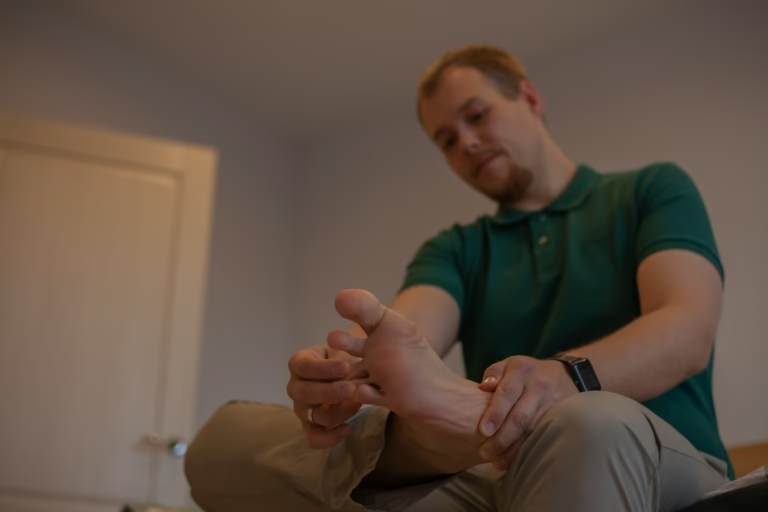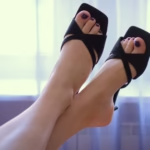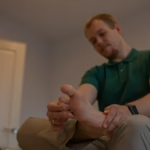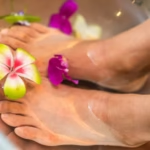Understanding Ball of Foot Pain
According to the American Podiatric Medical Association, an astonishing 75% of us adults will be plagued by foot pain at some point in their lives – and typically its the ball of the bottom of the foot thats the main culprit behind all the agony.
At Physio Whisper, we get our fair share of patients coming through our doors – often hobbling in a bit, looking pretty fed up and bewildered – trying to figure out how a tiny spot on the sole of their foot can be such a pain in the neck. But the ball of foot pain, or as the medics call it metatarsalgia, is more than just a minor annoyance – it can actually start to knock your balance out, mess up your entire gait and even get you down in the dumps.
In this guide, we’re going to take a good hard look at what actually causes the pain in the first place, what physio can do to start soothing the pain, and most importantly, what steps you can start taking right now to make sure it doesn’t come back and cause you more grief in the long run.
Understanding the Issue
The ball of your foot – it’s the spot right behind your toes where your foot smacks the ground with every step. It’s basically the shock absorber of your foot, especially when you’re going for a walk, jog, or dance.
Pain in that area can feel like you’re walking on a rock or a bruised spot. It’s a real pain, literally, and it can quickly turn everyday tasks like going to the grocery store or playing with the kids into a real struggle.
Think of it like this – you show up to a wedding in your favourite shoes but by the time the night’s over you’ve ditched them because your poor feet are screaming for some relief. That’s ball of foot pain making an entrance!
It usually crops up because of too much pressure, shoes that just aren’t right for you, or simply overdoing it. However it can also be a sign of an underlying issue – like the way you walk or really tight calf muscles – both of which can be sorted with a bit of physio.
Identifying Symptoms and When to Seek Help
Early detection really can make all the difference … but when you’re dealing with ball of foot pain – things can sneak up on you & get a lot worse if you don’t take notice
Common signs of this problem are:
- A burning/aching/sharp pain lurking under the ball of your foot – & it can be a real nuisance
- Pain that gets worse the more you’re on your feet – whether that’s standing, walking or running around
- You might even get tingling/numbness in your toes
- Some people describe it as being like “standing on a brick”
- And to top it all off, it can be pretty miserable when you’re wearing shoes that are too tight or high-heeled
If the pain sticks around for more than a week, starts limiting your mobility or starts getting in the way of day-to-day life, then it’s high time you got an appointment with a physiotherapist or healthcare professional. At Physio Whisper, we reckon getting a problem assessed as soon as possible is key – that way we can stop it getting any worse & get you back on your feet – with no pain a problem.
Treatment Options and Relief Strategies
The good news? Most cases of ball of foot pain can be fixed with simple physiotherapy based care and lifestyle changes.
Here are some strategies we recommend to our patients:
- Footwear Check: Wear shoes with good arch support and cushioning. Avoid narrow toe boxes and high heels for long periods.
- Custom Orthotics: Insoles can redistribute pressure across your foot.
- Targeted Exercises: Strengthen and stretch your calf, toes and arches to improve foot mechanics.
- Manual Therapy: A physio can use hands on techniques to relieve tension and improve joint mobility.
- Rest and Ice: Short term rest and ice after long days of standing.
- Gradual Activity Resumption: Don’t rush back into walking or running.
The goal isn’t just pain relief but to get you back to feeling confident in every step. At Physio Whisper we combine movement therapy, education and footwear guidance for full recovery.
Expert Insights and Research
Research shows physio and exercise works for foot pain. A 2020 review in Journal of Foot and Ankle Research found foot specific strengthening and load management reduces pain and improves walking patterns in forefoot pain.
We once worked with a teacher who stood for 8 hours a day. After 4 weeks of targeted physio — calf stretches, orthotic support, posture training — she was pain free and even started her evening jogs again.
That’s the magic of understanding your body and giving it the right care.
Preventative Measures for Long-Term Health
Prevention is the best medicine — and your feet will thank you! Keeping them strong and supported means long term comfort and mobility.
Here are some prevention tips:
- Stretch Daily: Loosen those tight calves and toes.
- Wear the Right Shoes: Comfort over style (most of the time!).
- Mind Your Weight Distribution: Alternate standing positions or use cushioned mats if you’re on your feet all day.
- Warm Up Before Exercise: Activate your feet like any other muscle group.
- Book in for Regular Physio Check-Ins: Small biomechanical imbalances can be fixed early with professional help.
Healthy feet means healthy movement — and that means more energy for the things you love.
Conclusion
Foot pain may seem small but it can affect your entire sense of movement and being. Knowing the causes, recognising symptoms early and following physiotherapy led relief strategies can get you walking again.
At Physio Whisper we believe every step should feel light, confident and pain free. Remember — movement is medicine and your feet deserve care as much as any other part of your body.
Could your feet be talking to you today?
References
- American Podiatric Medical Association – https://www.apma.org/
- Journal of Foot and Ankle Research – https://jfootankleres.biomedcentral.com/
- Mayo Clinic – https://www.mayoclinic.org/
- Physiopedia – https://www.physio-pedia.com/
- WebMD – https://www.webmd.com/














